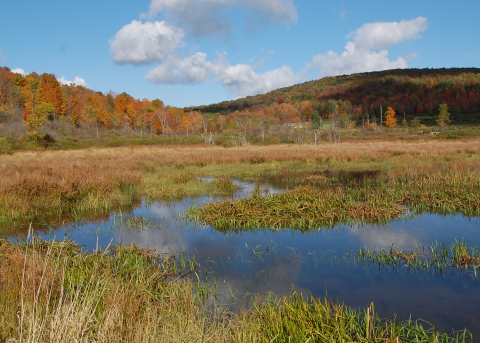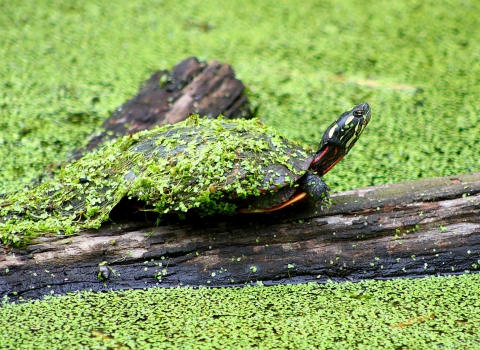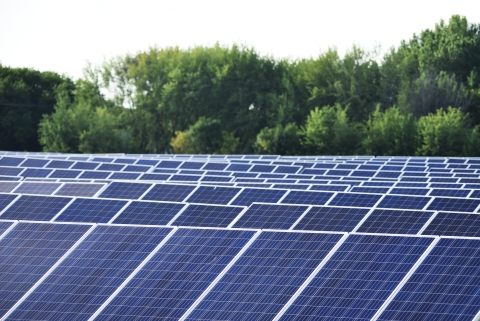Conservation Planning Assistance
Conservation Planning Assistance aids state and federal regulatory agencies in minimizing the impacts of Federally- licensed, permitted, or funded projects on fish and wildlife resources. Our role in the review of these projects is mandated by the Fish and Wildlife Coordination Act, a law which requires Federal agencies to consult with the U.S. Fish and Wildlife Service (Service) on all projects that may impact wetlands, streams, lakes, and rivers. Land and water regulatory agencies, such as the U.S. Army Corps of Engineers and Federal Energy Regulatory Commission (FERC), rely on the biologically sound recommendations of our agency to minimize the environmental impacts of projects that they implement or authorize.
Our responsibilities include:
- Promoting development options that conserve fish and wildlife habitat
- Protecting and providing buffers for wetlands and aquatic resources
- Ensuring fish passage fish passage
Fish passage is the ability of fish or other aquatic species to move freely throughout their life to find food, reproduce, and complete their natural migration cycles. Millions of barriers to fish passage across the country are fragmenting habitat and leading to species declines. The U.S. Fish and Wildlife Service's National Fish Passage Program is working to reconnect watersheds to benefit both wildlife and people.
Learn more about fish passage at hydroelectric plants - Maintaining and improving stream flows and habitat
Federal Permitting and Project Information
The U.S. Army Corps of Engineers coordinates with the Service on all proposed construction projects for flood control, shoreline stabilization, or navigation as required under the Fish and Wildlife Coordination Act. The Service’s role is to ensure that construction is planned with a view toward conservation of fish and wildlife. Every year, the New York Field Office reviews approximately 250 public notices prepared by the U.S. Army Corps of Engineers and U.S. Coast Guard. In these public notices, applicants propose to impact wetlands, streams, and other water bodies. The Service is effective at reducing the impacts of these projects on fish and wildlife resources and ensuring that mitigation is provided to achieve fish and wildlife benefits.
Resources:
- Army Corps of Engineers Projects in New York
- Buffalo District, U.S. Army Corps of Engineers, Regulatory Program
- New York District, U.S. Army Corps of Engineers, Regulatory Program
Hydropower
The New York Field Office reviews non-Federal hydroelectric projects that are licensed by the FERC under the Federal Power Act. There are over 190 operating or proposed projects in New York, encompassing over 240 hydroelectric developments. The major issues addressed by the Service include protecting fish from turbine or other project-related mortality, providing upstream and downstream fish passage past dams, providing adequate water flows downstream of projects and in dewatered river reaches, reducing reservoir fluctuations, reducing impacts to wetlands and nesting birds, and providing public access. In the past 30 years, we have been instrumental in negotiating 30 settlements incorporating 97 hydroelectric developments on 20 rivers in New York. Over the next 10 years, the New York Field Office will have the largest workload in the country with 73 hydroelectric projects and 99 individual developments to be relicensed.
By working with hydropower licensees and other stakeholders, the New York Field Office has helped achieve numerous measures for the protection, mitigation, and enhancement of fish and wildlife resources affected by hydroelectric projects. These achievements include:
- Reestablishment of water to 114 dewatered river reaches (the area between the dam and powerhouse where water is bypassed to generate power) resulting in 55 river miles being restored for fish and other aquatic organisms
- Provision of 39 base flows downstream of hydroelectric projects, protecting 313 river miles of aquatic habitat
- Installation of 125 exclusion devices to deter fish from entering the turbines
- Installation of 104 downstream and 7 upstream fish passage facilities, opening 660 and 858 river miles of mainstem habitat, respectively, for fish
- Installation of 19 eel ladder structures, opening 595 river miles of mainstem habitat for American eel
- Reductions in reservoir fluctuations at 34 hydroelectric projects, protecting 35,200 acres of shoreline and reservoir habitat
- Establishment of 14 conservation funds, resulting in a total of $150 million for ecological enhancements and recreation
Colliersville Hydroelectric Project
The relicensing of the Colliersville Hydroelectric Project on the Susquehanna River in 2019 provides an example of the New York Field Office’s conservation efforts. American eel was of specific conservation concern due to recent population declines. By working with the licensee and other stakeholders, we were able to establish minimum water flows into the bypassed reach; prescribe an eel ladder to provide seasonal upstream passage; prescribe downstream passage facilities suitable for American eels and other resident fish species; and install an exclusion screen on the intake structure to deter fish from entering the turbines. The fish passage facilities are to be designed in consultation with the Service’s fish passage engineers and the State.
Resources:
- NYFO Hydropower Project Highlights
- FERC: http://www.ferc.gov
- NYPA (St. Lawrence): http://stl.nypa.gov
- NYPA (Niagara): http://niagara.nypa.gov
Renewable Energy (Solar and Wind)
The New York Field Office plays an important role in the development of New York State’s solar and wind energy resources. We are partnering with other stakeholder agencies and organizations involved in bringing electrical energy generated by solar and wind power to the State’s transmission grid, and ultimately to consumers. Solar and wind energy are expected to meet increasingly more of our State’s electrical demand for energy generated from renewable sources. They produce no emissions and are generally environmentally clean technology. The New York Field Office will continue to consult with project sponsors prior to solar or wind energy construction to assess if proposals might adversely affect natural resources or threatened and endangered species such as bald eagles, Indiana bats, or piping plovers.
Resources:





